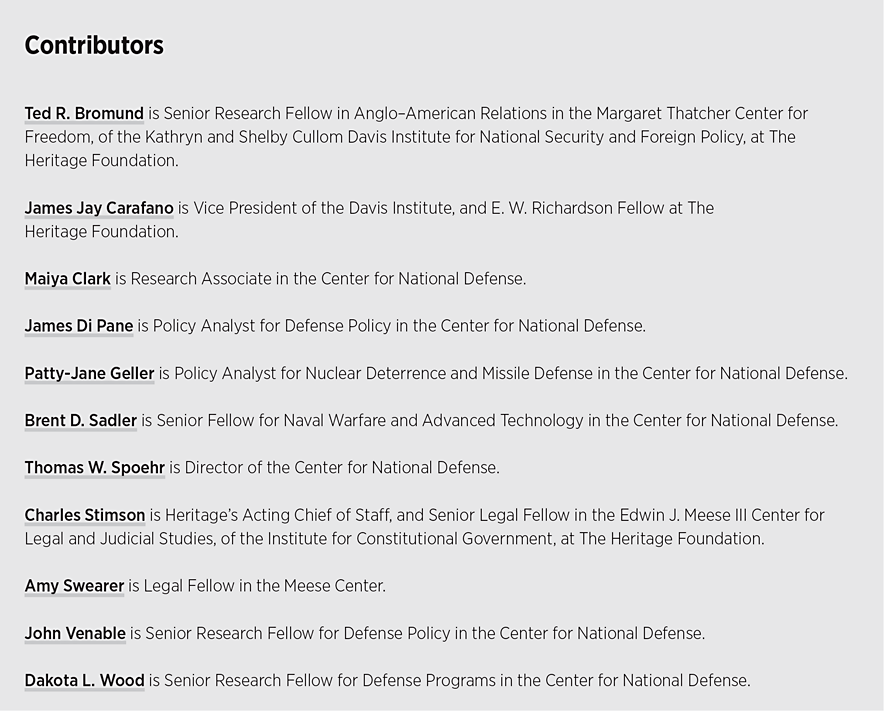The National Defense Authorization Act (NDAA) for fiscal year (FY) 2022 has passed with wide bipartisan margins—by 316 to 113 votes in the House of Representatives.REF Once the Senate acts, lawmakers will have to reconcile the differences between the two versions of the bill.
Both versions share one laudable characteristic: They increase the resources dedicated to the national defense and thus allow the Department of Defense (DOD) to prepare for better deterrence of conflict with China and Russia.REF As the new 2022 Index of U.S. Military Strength reports, more attention and resources are needed in order for the U.S. Armed Forces to develop the capabilities required to counter the threats posed by U.S. adversaries abroad.REF
The NDAA should narrowly focus on the areas that increase the nation’s military capability, capacity, and readiness. Congress took an important step in that direction by funding most of the unfunded priorities submitted by the senior officers in each of the Services. This action suggests that Congress recognizes the insufficiency of the initial budget request submitted by President Joe Biden.REF However, there are still some important issues to be resolved. This Backgrounder highlights important provisions in both versions of the NDAA that lawmakers should emphasize.
Military Capabilities
To assist the Armed Forces’ main mission of deterring adversaries and, when necessary, defeating them on the battlefield, Congress should:
Maintain Army Training Funds. The House version of the 2022 NDAA cuts training funds for Army maneuver units by $246 million. The Senate version does not. The Army has already scaled back its aspirations for training, stating that it is emphasizing proficiency at lower levels, such as companies and platoons, due to a lack of training funds.REF The Senate version should prevail.
Follow Army Priorities When Adding to Equipment Procurement. When the Senate increased the DOD budget request by approximately $24 billion, it scrupulously adhered to the Army’s unfunded list in terms of equipment procurement.REF The House took a very different approach, and its additions failed to adhere closely to the Army’s unfunded list, which includes the addition of $211 million specifically for UH-60M helicopters for the Army National Guard. The Senate’s method of addressing the procurement items that Army leadership identified as priorities should prevail.
Reduce Unrequested Add-Ons to Army Research, Development, Test, and Evaluation (RDT&E). Both the House and Senate added money to Army RDTE accounts, most of which was not requested by the Army in its unfunded priorities list. The House added a net of $633 million, while the Senate added a net of $306 million. The Senate’s adds more closely adhered to the Army’s unfunded list, although roughly two-thirds of the Senate’s add-ons were not requested by the Army. Only those RDT&E add-ons requested by the Army’s unfunded priorities list should be authorized.
Support the Larger House Budget for Navy Shipbuilding. The House version proposes larger funding than the Senate version for critically needed Navy shipbuilding. This includes $1.2 billion more for a large amphibious assault ship to replace the Bonhomme Richard (lost to fire last year), $3.06 billion for an additional destroyer, and $567 million in crucial capital investments to expand industrial capacity to build three attack submarines a year, instead of the current rate of two per year. The Senate makes similar, but smaller, increases for advanced procurement of ship parts, and does not address needed capital investments for submarine construction. The House’s shipbuilding provisions should prevail. Additionally, in a welcome move, both versions provide funding to keep three of seven cruisers from being decommissioned, which President Biden had proposed retiring. Maintaining these three cruisers will help the Navy to sustain a larger fleet, needed to deter Chinese aggression.
Adhere to U.S. Marine Corps (USMC) Modernization Measures. Both the Senate and House Armed Services Committees fully support USMC measures to modernize and to shift its focus to challenges in the Indo–Pacific region, with China as the pacing threat. The USMC has divested itself of tanks and heavy bridging and is preparing to reduce its inventory of tube artillery in favor of amphibious combat vehicles (ACVs), ground-based anti-ship missiles (GBASM), and multiple-launch rocket artillery. Congress has supported the USMC’s request for full production rates for the ACV and the Joint Light Tactical Vehicle. Aviation modernization (of the F-35B/C, KC-130J, and CH-53K) is also supported by both the Senate and the House. Both chambers demonstrated equal support for items on the USMC’s unfunded priorities list, such as one additional KC-130J tanker, two additional CH-53K heavy helicopters, eight additional Ground/Air Task Oriented Radar (G/ATOR) systems, and additional resources for GBASM.REF
Due to overall budgetary guidance, the Marine Corps is sacrificing end strength to fund its modernization and reorientation. The FY 2022 budget, even as amended by Congress, will result in a loss of 2,704 Marines in the active component.REF It is a worrisome trend that has seen the Marines lose capability over time, and Congress should watch it closely.
Not Create a Separate National Guard and National Reserve for the Space Force. There will be Guardians (members of the Space Force) who will want to separate from the Service for stints in the civilian sector and return later. It makes sense to give them the opportunity to continue to serve in the meantime by joining the Guard or the Reserve, which was recognized by the White House and both chambers of Congress in the budget request and NDAA, respectively.
There are three basic options to allow Guardians to work in the private sector and return to service, and each has been addressed to a degree through the House and Senate NDAAs, as well as the response of the executive branch to those drafts. The House bill incorporates the formation of a Space National Guard but says nothing about a Reserve Space Component.REF The Senate legislation incorporates a name change of Air National Guard to the Air and Space National Guard but does not establish a separate Space Guard component.REF On the other hand, the White House is adamantly opposed to establishing a separate Space National Guard because of the additional administrative costs.REF While none of the three options addresses the Reserve, the Senate Armed Services Committee has previously advocated a Space Reserve Component.REF
There will be times when it will make sense to tap into a Reserve Space component and a Guard Space component, but neither body would be large enough to justify the administrative weight of establishing separate components. The final NDAA should include the Senate language to change both standing component names from Air National Guard and Air Force Reserve to “Air and Space National Guard” and “Air and Space Force Reserve,” respectively.
Remove Unreasonable Limitations on the Procurement of the F-35 Fighter. The House NDAA markup includes a provision that caps the number of F-35s that the Services may buy, based on a limitation that has never applied to any other fighter—including new fighters currently being acquired.REF The House version would require the Services to project and then calculate the cost per tail (CPT) of each F-35 variant (F-35A, F-35B, and F-35C) for FY 2027. It then caps the number of aircraft the Services are allowed to acquire by dividing that funding ceiling for each variant ($4.1 billion for the F-35A, $6.8 billion for the F-35B, and $7.5 billion for the F-35Cs) by the CPT for each type of fighter. What is more, the NDAA requires that programmed modification costs be added to the F-35 CPT figures—for annual manpower, operations, maintenance, and continuing system support.
The F-35 is the most advanced multirole fighter ever fielded, and its decades-long production run was designed to incorporate hardware and software upgrades that would stay ahead of future advances in threat systems.REF Unlike other fighter programs of record where programmed acquisition costs are separated from future upgrades, the infrastructure and manpower costs required to study the threat and then design and implement future production-line upgrades were built into the F-35’s block upgrade program.
The Air Force and the F-35 Joint Program Office is taking a novel approach with the F-35 by “retrofitting” early aircraft blocks with the upgraded hardware and software associated with the latest production standard. While it is an ideal solution to upgrade all fighters to the latest specification, it is a costly strategy that has not been executed with the previous jets, such as the F-16. While it would have been ideal to upgrade the F-16 Block 25s, 30/32s, and 40/42s to the Block 50/52 hardware and software standards, it would have meant the upgrade of more than 900 fighters at an unreasonably high cost. While the Air Force did upgrade each of those F-16 blocks separately, it never attempted to bring them up to the next block standard—much less all the way up to the high Block 50/52 standard.
While the F-35 acquisition strategy will keep the fleet of F-35s viable for decades to come, it is novel, overly costly, and coming back to haunt the F-35 program of record, as those “future” modifications are being used by Congress—and, unbelievably, the Air Force—to condemn the cost of the F-35 and limit its fielding. To limit fighter acquisition costs, Congress should stop the upgrade/retrofit program intended to bring early blocks of the F-35 up to current production line standards—and it should immediately stop the acquisition of the F-15EX and F/A-18E/F and use that funding to acquire and field fighters that will be operationally viable in the next war.REF
Not Increase F-15EX Procurement. The House version of the NDAA includes 12 extra F-15EX fighters, at a total cost of $1.376 billion.REF The purchase of any fourth-generation fighter, particularly one that costs 30 percent more to acquire than the F-35, is misguided, and the House’s push to increase the number of F-15EX jets being acquired only compounds the problem. That fighter is not going to be viable in a scenario of great-power competition and thus does not alter U.S. adversaries’ calculation for action.REF Congress should not adopt the increase proposed by the House version of the bill, as it would mean procuring yesterday’s fighters for tomorrow’s battles.
Authorize Funding for the B83 Gravity Bomb Life-Extension Program. The House bill eliminates funding for the B83, but, while the B83 is an old weapon, it must remain in the stockpile until a replacement is identified because it is the best weapon available for holding hard and deeply buried targets at risk.REF As adversaries improve their hardening and tunneling capabilities over time to protect critical assets, such as command-and-control nodes, maintaining the ability to hold these targets at risk remains necessary for deterrence.REF Congress should restore the funding eliminated in the House bill.
Keep the Senate Provision That Establishes the Congressional Commission on the Strategic Posture of the United States.REF With China set to become a nuclear peer to the United States and Russia, the United States will need to deter two countries at once, a first in its history. As a result, the current U.S. nuclear posture, established in 2010, may no longer suffice.REF A strategic commission provides the United States with an opportunity to assess and adjust U.S. force posture to address the increase in threat.
Keep the House Provision That Requires Certification for Future Funding of the Homeland Defense Radar-Hawaii (HDR-H).REF The HDR-H is needed to ensure discrimination-radar coverage over Hawaii, but the program’s progression has depended on congressional funding additions every year due to lack of funding in current and previous Administration budget requests. Including the HDR-H in future budgets would stabilize program funding.
Keep the Senate Provision That Directs the Government Accountability Office to Review and Provide a Briefing on DOD Recruitment and Retention of Military Cybersecurity Personnel. Talented and experienced personnel are critical to success in the cyber domain, and these personnel are also in high demand in the private sector. Ensuring that the DO D is doing the most it can to attract and retain talent is an important initiative. Qualified cyber personnel, such as coders and programmers, are essential to the mission, and every effort should be made to ensure that the U.S. military can attract and retain them.REF
Keep the Senate Provision That Requires Assessment of U.S. Adversaries’ Offensive Cyber Capabilities and of the Plans to Use Offensive Cyber Operations During a Conflict. The cyber domain will be a critical part of any future conflict. Ensuring that the U.S. military is prepared to employ cyber operations effectively, and that it understands what adversaries are capable of, will help to mitigate the risk to national security. An unclassified version of this assessment should be made available to Congress and the American public to increase oversight of the state of U.S. cybersecurity.REF
Keep the Senate ProvisionThat Requiresa Report on Cyber Threats and Vulnerabilities. The Senate bill requires a report on how the DOD can support the Cybersecurity and Infrastructure Security Agency (CISA) to increase awareness of threats and vulnerabilities. Strengthening the coordination between DOD and the Department of Homeland Security (DHS) will help to protect American networks through better situational awareness. CISA also provides an excellent platform for distributing threat intelligence to federal, state, and private-sector partners.REF
Personnel Management
Many of the provisions in the bill deal with how the DOD manages its people and its recruitment and retention policies. In those areas, Congress should:
Reject Section 529 of the House Bill. Section 529 would authorize military judges and magistrates to issue military court protective orders, barring subjects of such orders from possessing firearms under federal law for the duration of the order, which may last up to six months and be renewed upon judicial review.REF Domestic violence is a serious problem, and temporarily removing firearms from those credibly accused of violence (but before conviction of a crime) can be an important tool for protecting victims from further harm. However, the legal framework for such orders must provide significant measures of due process befitting the suspension of a person’s enumerated rights. Quite simply, Section 529’s due process protections are far from sufficient.
Protective orders under the section would require a judge to find by a mere “preponderance of the evidence” that a person “represents a credible threat to the alleged victim’s physical safety.” Even more concerning is the section’s clause on emergency ex parte orders, which leaves the entire mechanism for due process to “such rules and limitations as the President shall prescribe.” That is not an articulable standard at all, much less a standard by which Congress should permit the unilateral suspension of a military member’s Second Amendment rights. Congress should remove this provision.
Reject the Minimum-Wage Increase for Contractors. The House version would force DOD contractors to pay a minimum wage of $15 dollars an hour starting on January 30, 2022, and then give the Secretary of Defense discretion to increase it further in coming years.REF According to the Congressional Budget Office, this section alone would cost the DOD $3.8 billion from 2021 to 2026.REF This means that it will create more inflationary pressure in the DOD’s budget and make it harder to build the capabilities needed for a secure America. Further, the wage increase will reduce the number of jobs since it increases the cost of labor and thus leads to a shrinking number of employees.REF The Senate should reject that section and let the market—not politicians—determine wages.
Reject the Expansion of the Selective Service System. Both chambers of Congress have provisions in their bills that would expand the Selective Service and require that women register for the draft. That is a misguided expansion of a system that should be dismantled and rethought. The likelihood of the Selective Service being used to increase the ranks of the Armed Forces is zero, and the system as currently constructed detracts from military readiness. As explained by James Carafano, vice president of The Heritage Foundation’s Davis Institute, because of the need to dedicate a portion of the operating forces to train the draftees who would join the Armed Forces, “the Selective Service System actively damages current readiness and capabilities.”REF
Further, “[t]he draft is an anachronism masquerading as something that’s still relevant. The draft contributes nothing to deterring the likes of China, Russia, Iran, or North Korea. The draft does nothing to build better citizens or patriotism, since other than filling out a form, it requires nothing from our youths.”REF The best path forward is to drop the expansion of the Selective Service and focus on provisions that actually improve military readiness.
Not Increase Parental Leave for Secondary Caregivers. Both the House and Senate versions of the NDAA increase the amount of leave granted to parents of a newborn or newly adopted child. Current law allows three weeks of parental leave for a secondary caregiver.REF The Senate version increases the amount of leave granted to a parent—whether primary or secondary caregiver—to 12 weeks.REF This is three times the annual amount of leave granted to Service members. This additional leave for secondary caregivers will have the effect of reducing military readiness by significantly reducing the number of Service members present for duty. If any change must be implemented, it should be the one in the House version, which is more limited.REF
Eliminate Changes to the Uniform Code of Military Justice (UCMJ), Which Would Undermine Good Order and Discipline in the Armed Forces. Both versions of the NDAA propose significant changes to the UCMJ, which, according to their sponsors, would increase trust in the military justice system by victims of sexual assault. While the intent is noble, the actual provisions would, over time, have the opposite effect, making the military justice system less effective, thus eroding the ability of leaders to fulfill their mission—to win wars.REF
The most damaging feature of the proposed changes is the removal of the authority of military commanders to refer charges to a court martial, and instead vest that authority in a new system of special-victim prosecutors, under the presumption that military commanders are not trusted to act in the best interests of victims in their units. There is no evidence that this radical change will have any positive effect, and most senior military leaders have argued against it.REF Preventing commanders from enforcing good order and discipline in their ranks, and giving court-martial-referral authority to military lawyers, undermines good order and discipline, and will result in fewer cases of sexual assault (or any crime for that matter) being referred to a court martial.REF
The legislative provisions would require the creation of an unnecessary and confusing parallel system of justice in the military, which, in turn, would require more funding and personnel to operate and create vastly more complexity. The House version of the NDAA would only transfer authority for sex-related crimes to these special-victim prosecutors, while the Senate version contains unreconciled direction to transfer either just sex crimes or all serious crimes to this new prosecutorial network. Regardless of which version is passed into law, there will be years of legal challenges to this scheme.
The Senate version also contains direction that requires the implementation of all recommendations set forth in Lines of Effort 2, 3, and 4 of the DOD report “Hard Truths and the Duty to Change: Recommendations from the Independent Review Commission on Sexual Assault in the Military.”REF Some of these recommendations have merit, such as recommendation 3.7b: “The Secretary of Defense should direct the Services to develop a formal system to share climate survey data at the unit level and initiate and evaluate corrective action plans.” But other recommendations are either too vague, or are already established DOD goals, such as 3.6: “[b]uilding a climate for the reduction of sexual harassment and sexual assault as a fundamental leader development requirement.” More analysis is needed before any of these recommendations is given the force of law, and this legislative provision should be eliminated.REF
The House version of the NDAA further calls for the appointment of a Service-level special-victim prosecutor of general rank or flag rank who would report directly to the Service Secretaries.REF This is inappropriate and unnecessary. Such an arrangement neuters the existing position of Judge Advocate for each service, the existing three-star senior military legal advisor to the Secretaries. This requirement would be a poor use of a general officer position, as the individual would have little utility at the headquarters. Congress should eliminate this provision.
Not Transfer Control of the District of Columbia National Guard to the Mayor. A provision of House version of the NDAA would transfer operational control of the DC National Guard to the mayor of the District.REF Due to the multiple overlapping lines of responsibility involved in protecting elements of the federal government located in the District of Columbia—the DOD, DHS, the Treasury, the DC police, the Department of Justice, and others—it is impractical and sub-optimal for the mayor—with limited perspective of the different actors involved—to exercise operational control of the DC National Guard. There is no such provision in the Senate version. Congress should eliminate the House provision.
Maintain the Disclosure Requirement for Contractors’ Training Materials. The Senate version of the bill has a provision that would require contractors to make available
diversity, equal opportunity, equity, inclusion, or tolerance training materials or internal policies, including syllabi, online sources, suggested reading lists, guest speakers and lecturers, instructor lists, internal policy memos, workshop descriptions, outside organizational funding, or other educational or professional materials for review and identification of Critical Race Theory or similar theoretical instruction in a timely manner.REF
Critical race theory (CRT) reduces individuals to their race and the racial categories of “oppressors” and “oppressed.”REF One of the precepts of CRT is that America is fundamentally a racist country. The use of CRT materials to indoctrinate defense-contractor personnel has the potential to disincentivize them to work in support of America.REF Congress should maintain the disclosure requirement.
Remove Onerous Reporting Requirements for Contractors on Immutable Characteristics. The House version of the bill contains a provision that would require defense contractors to report the demographic characteristics of its employees and their major occupational group.REF It would further require a report on diversity programs established within their companies, including hours and resources spent on them. It is an effort to further divide society and the workplace along racial lines, and to further drive up already burdensome compliance costs for military contractors.REF It is a recipe for a smaller and less effective defense industrial base. Congress should drop the provision.
Retain the Provisions on Transnational-Repression Accountability. The House version of the NDAA contains many, though far from all, of the provisions of the Transnational Repression Accountability and Prevention (TRAP) Act, introduced in both the Senate and the House, on a bipartisan basis, in slightly different forms in 2019 and 2021.REF The TRAP Act is a response to the problem of transnational repression—the harassment and intimidation of opponents and victims across borders by authoritarian regimes—and, specifically, to the problem of the abuse of Interpol as a specific kind of transnational repression.REF While Interpol is not, contrary to popular misconception, an international police force, it is a valuable means of fostering international law-enforcement cooperation. The abuse of Interpol for political purposes thus reduces the contribution that Interpol can make to U.S. law enforcement.
The TRAP provisions in the House version continue to require robust U.S. reporting on Interpol abuse, and mandate that the U.S. oppose this abuse. But, in some respects, these provisions are a step back from the previous TRAP Acts. The House version removes the requirement that the State Department’s “Country Reports” assess Interpol abuse, as well as the detailed provisions for interagency coordination of previous TRAP Acts. The House version of the TRAP Act considerably weakens the requirement that the U.S. propose censures of Interpol member countries that repeatedly abuse it. It does contain a provision that bars the use of Interpol Red NoticesREF as the sole basis for an extradition—but this provision is far weaker than the comparable provisions in previous TRAP Acts. On the positive side, the NDAA version of the TRAP Act breaks new ground by including provisions that prevent banks from closing accounts based solely on Red Notices, a requirement that will help to prevent Interpol abuse from leaking into the U.S. banking system.
The House TRAP Act is not perfect and is weaker than the stand-alone TRAP Acts that preceded it. But it does set a new standard for reporting on, and limiting, the influence of Interpol abuse, and clearly demonstrates U.S. opposition to this abuse as a central pillar of transnational repression. The House provisions can and should be improved, but even in their current form, they deserve to be retained in the NDAA.
Internal Management
Some of the provisions of the NDAA deal with the internal management of processes at the DOD and questions related to how the DOD interacts with the nation. To better shape these areas for the future, Congress should:
Support the Creation of a Commission to Review the National Defense Strategy. The Senate version of the NDAA contains a provision (Sec. 1061) to create a commission to review the National Defense Strategy. The commission that reviewed the 2018 National Defense Strategy produced a very informative bipartisan report.REF Congress should have an independent check on the National Defense Strategy, which is developed by the executive branch. Congress should adopt this provision.
Preserve the Reform Commission on the Planning, Programming, Budgeting, and Execution (PPBE) System. Both the Senate and House versions have a provision that would create an independent time-bound commission to develop recommendations for reforming the system that develops the DOD budget request within the Pentagon.REF The Senate version of the commission includes two important features that should be preserved: (1) the absence of elected officials and (2) a preliminary report at the 180-day mark.
The House version of the commission asks for four elected officials in a commission of 14 people. This creates a risk of diluting the expertise of the commission and of the final work itself. The preliminary report is a valuable concept that brings the concepts being discussed by the commission to the forefront before there is a full report. The commission would have a valuable opportunity to shine a light on, and propose changes to, a system that is too cumbersome and too slow to respond to changes in budgetary conditions.REF Congress does need to avoid the trap of trying to legislate internal DOD systems since it would likely make the system even less responsive.
Keep the House Provision on Operations and Maintenance (O&M) Budget Justification. The House version has a provision that requires the DOD to submit more detailed information on how the O & M budget is organized and justified.REF The O&M package is by far the least-detailed budget justification, and the provision endeavors to receive more detailed information and links between input and output. It would be a good-governance practice to have more details on the O&M resources to start connecting the input of money to the outputs generated by O&M funds, such as levels of readiness and levels of building maintenance.
Reject Additional Domestic-Content Requirements for Defense Programs. The House bill includes a provision requiring the minimum domestic content for defense programs to increase from the current 50 percent to 65 percent by 2024, and to 75 percent by 2029.REF (Currently, all end products purchased by the U.S. government are required to be manufactured domestically and be made “substantially” of domestic parts, which is interpreted to mean that at least 50 percent of the end product’s components must be U.S.-made, subject to certain exceptions.REF) Increasing the domestic-content requirements for defense programs hurts U.S. alliances by cutting allies’ defense industries from U.S. defense programs.REF It also places burdens on prime contractors and subcontractors, who must seek out new domestic suppliers for components that were previously sourced overseas. All of this, in turn, increases the end costs of U.S. defense programs. Congress should reject this provision.
Remove Provisions That Unnecessarily Increase Costs. There are multiple provisions within the House bill that would unnecessarily increase costs and create delays in military construction and in the acquisition process.REF One of the provisions requires military constructions to achieve net-zero emissions by 2035, at a time when military construction is already facing a substantial backlog.REF This type of provision guarantees an even bigger backlog and higher cost.REF There are other provisions that would require the defense industrial base to weight climate change considerations in its development of projects and products, including international partners in the national technology and industrial base.REF Such provisions will make it even harder to sell to the DOD, and Congress should drop them from the bill.
Conclusion
The Armed Forces are in the midst of a substantial change in how they execute deterrence and prepare for war. The effort to refocus the DOD to great-power competition started in earnest with the 2018 National Defense Strategy. The effort is not a discrete event but an ongoing process that will take time and resources: The challenges of increasing the size of the Navy fleet are representative of the time horizon needed. In this endeavor, Congress is an equal partner with the executive branch, and the FY 2022 NDAA represents a critically important opportunity to strengthen U.S. national defense. While both the Senate and House versions of the FY 2022 NDAA are a step in the right direction, Congress can improve the final NDAA.
Frederico Bartels is Senior Policy Analyst for Defense Budgeting in the Center for National Defense, of the Kathryn and Shelby Cullom Davis Institute for National Security and Foreign Policy, at The Heritage Foundation.











